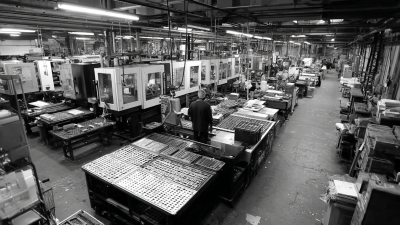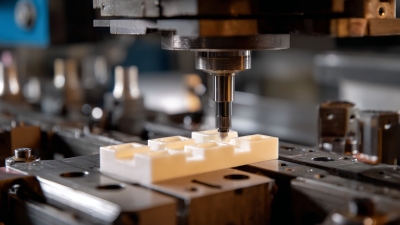Unlocking the Potential of Small Run Injection Molding for Rapid Prototyping and Cost Efficiency
In today's fast-paced manufacturing landscape, the demand for rapid prototyping and cost efficiency has led to the emergence of innovative solutions, particularly in the realm of small run injection molding. This technique, characterized by its ability to produce low volumes of high-quality parts, addresses the needs of industries such as automotive and aerospace, where time-to-market is critical. According to a recent market report by Smithers Pira, the global injection molding market is expected to grow to $230 billion by 2025, driven by advancements in technology and materials that enhance production capabilities. Small run injection molding not only reduces lead times but also mitigates the financial risks associated with large-scale production runs, allowing companies to test and refine their designs more effectively. As industries increasingly recognize the value of flexibility and speed, small run injection molding stands out as a pivotal enabler of innovation and efficiency in product development.

Understanding Small Run Injection Molding and Its Applications
 Small run injection molding is an innovative manufacturing process that allows for the efficient production of limited quantities of parts or products. This technique is particularly beneficial for businesses looking to create prototypes or test out new designs without the high costs and lengthy timelines typically associated with traditional injection molding methods. By utilizing specialized molding machines and optimized production techniques, small run injection molding enables rapid turnaround times, making it an ideal choice for industries such as automotive, medical devices, and consumer goods.
Small run injection molding is an innovative manufacturing process that allows for the efficient production of limited quantities of parts or products. This technique is particularly beneficial for businesses looking to create prototypes or test out new designs without the high costs and lengthy timelines typically associated with traditional injection molding methods. By utilizing specialized molding machines and optimized production techniques, small run injection molding enables rapid turnaround times, making it an ideal choice for industries such as automotive, medical devices, and consumer goods.
The applications of small run injection molding extend beyond mere prototyping. It offers manufacturers the flexibility to produce custom parts tailored to specific needs while maintaining cost efficiency. Startups and small businesses can leverage this technology to minimize waste and invest in the development of innovative products, thereby enhancing their competitive edge in the market. Furthermore, as the demand for personalized and intricate designs rises, small run injection molding stands out as a viable solution, accommodating design iterations and adjustments seamlessly throughout the production process.
Benefits of Small Run Injection Molding for Rapid Prototyping Processes
 Small run injection molding is emerging as a critical solution for businesses looking to streamline their rapid prototyping processes. This method allows manufacturers to create limited quantities of parts with high precision and repeatability. By leveraging small run injection molding, companies can significantly reduce lead times, enabling quicker iterations of product designs. This is particularly beneficial for startups and innovators who need to test ideas and bring products to market rapidly without the hefty investment typically associated with traditional injection molding.
Small run injection molding is emerging as a critical solution for businesses looking to streamline their rapid prototyping processes. This method allows manufacturers to create limited quantities of parts with high precision and repeatability. By leveraging small run injection molding, companies can significantly reduce lead times, enabling quicker iterations of product designs. This is particularly beneficial for startups and innovators who need to test ideas and bring products to market rapidly without the hefty investment typically associated with traditional injection molding.
Moreover, small run injection molding provides excellent cost efficiency. Conventional manufacturing processes often require large minimum order quantities to justify the initial setup costs. In contrast, small run production allows for smaller batch sizes, which means companies can save on both material and labor costs while minimizing waste. This flexibility enables quicker adjustments in design based on feedback, promoting a more agile approach to product development. Consequently, small run injection molding not only enhances the speed of prototyping but also supports a more cost-effective pathway for evolving product ideas, making it a favored choice in today's dynamic market landscape.
Cost Efficiency Analysis: Comparing Small Run Injection Molding to Traditional Methods
Small run injection molding offers a compelling alternative to traditional manufacturing methods, especially when it comes to rapid prototyping. This technique utilizes advanced technologies to produce small batches of high-quality plastic parts efficiently. When compared to conventional methods like CNC machining or 3D printing, small run injection molding can significantly reduce production costs and timeframes, making it an ideal option for startups and businesses looking to innovate without heavy financial burdens.
Tip: When considering small run injection molding, assess your design for manufacturability (DFM). Optimizing your designs can lead to better mold performance and reduced waste, ultimately enhancing your cost efficiency.
In addition to lower material costs, small run injection molding provides the advantage of consistent part quality. Traditional methods may yield variations between units, but with injection molding, each part is produced from the same mold under controlled conditions. This uniformity ensures that prototypes are representative of the final product, allowing for more accurate testing and development.
Tip: Always collaborate closely with your mold maker during the design phase to anticipate potential issues. Early communication can save time and expenses in the long run by addressing concerns before they escalate.
Unlocking the Potential of Small Run Injection Molding for Rapid Prototyping and Cost Efficiency
| Criteria | Small Run Injection Molding | Traditional Methods |
|---|---|---|
| Setup Time | 1-2 weeks | 4-6 weeks |
| Cost per Prototype | $1,000 - $5,000 | $10,000 - $50,000 |
| Production Volume Optimization | 1-500 units | 500+ units |
| Material Variety | Moderate | Extensive |
| Lead Time | Short | Long |
Best Practices for Implementing Small Run Injection Molding in Product Development
Small run injection molding is an increasingly popular choice for product development, particularly for rapid prototyping and cost efficiency. Implementing this technique effectively can significantly enhance the design process and reduce time to market. To maximize these benefits, it’s essential to follow some best practices.
**Tip 1:** Start with a clear design. Before beginning the molding process, ensure that your design is optimized for injection molding. This means simplifying geometries where possible and considering factors like wall thickness and draft angles to facilitate easier demolding.
**Tip 2:** Choose the right material. Selecting the appropriate plastic for your prototype is crucial. Different materials offer various properties such as strength, flexibility, and thermal resistance. Consider the end-use of your prototype when making this choice, as it can impact its overall performance and feasibility.
**Tip 3:** Work with experienced professionals. Partnering with experts in small run injection molding can save time and resources. They can provide invaluable insights into mold design, processing parameters, and troubleshooting, ensuring a smoother development cycle and higher quality prototypes.
Impact of Small Run Injection Molding on Product Development Efficiency
This chart illustrates the advantages of Small Run Injection Molding compared to traditional molding processes. It highlights reductions in design time, production costs, and lead time, showcasing its potential for enhancing efficiency in product development.
Future Trends in Small Run Injection Molding for Innovative Manufacturing Solutions
The future of small run injection molding is poised to revolutionize the landscape of innovative manufacturing solutions. As businesses increasingly seek to reduce lead times and optimize costs, advancements in technology are making it possible to produce high-quality prototypes more efficiently than ever. The integration of automation and advanced materials not only enhances the speed of production but also allows for greater flexibility in design iterations. This opens up avenues for small and medium enterprises to compete with larger firms by offering customizable solutions that meet specific client needs without the burden of large-scale production.
Moreover, the trend towards sustainability is driving change in small run injection molding processes. Manufacturers are exploring the use of recyclable and bio-based materials to reduce environmental impact while maintaining product integrity. Additive manufacturing techniques can be combined with traditional molding methods, enabling a seamless transition from prototyping to final production. This hybrid approach empowers companies to innovate rapidly while adhering to sustainability goals, positioning small run injection molding as a critical component of the future manufacturing landscape. As these trends continue to evolve, the potential for small run injection molding in fostering creativity and efficiency in product development is immense.
Related Posts
-

Maximizing Your Investment with Exceptional After Sales Service in Low Volume Injection Moulding
-

How to Maximize Efficiency in Small Volume Injection Molding: Industry Insights and Best Practices
-

What is an Injection Machine and How Does it Transform Manufacturing
-

Ultimate Guide to Choosing the Right Injection Machine for Your Manufacturing Needs
-

The Definitive Ultimate Guide to Sourcing the Perfect Injection Machine for Your Business Needs
-

Exploring Cost Efficiency in Low Cost Injection Molding at 2025 China Import and Export Fair